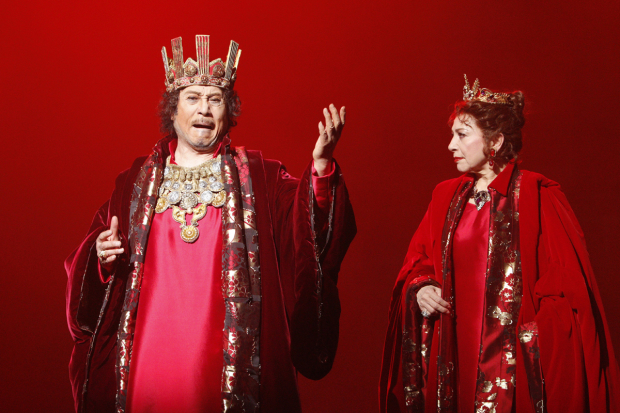Hamlet (Barbican Centre)
Yukio Ninagawa returns to direct the tragedy 40 years after presenting his first Shakespeare

© Takahiro Watanabe
Yukio Ninagawa is onto his eighth Hamlet. London has seen two of them before: one set in a warren of actors’ dressing rooms, drawing on the artificiality; the other, toying with the idea of Elsinore as a prisoner. His latest, brought to the Barbican by his longstanding British producer Thelma Holt to mark the Japanese director’s 80th birthday, takes a historical perspective.
Set in the 19th Century, when the play was first introduced to the country, Ninagawa’s Hamlet is a kind of ersatz recreation. He imagines an original production taking place in a small, run-down village – yes, this really is Hamlet in a hamlet – using the town square as a playing space.
Historically, this was the moment Japan opened up to western influences – hence Hamlet‘s arrival – but it also started to define its differences as a result, specifically with regards loyalty to the emperor. Formally, this is a fusion, performed as declamatory naturalism, but infused with traditional kabuki and noh effects: the clack of tsuke clappers to emphasis key poses, shrieking flutes to stress fraught moments. Politically, it’s a kind of agit-prop. It questions the place and propriety of deference to the emperor.
Mikijiro Hira’s Claudius comes as two men; one is majestic in a vast red and gold-gilt cloak; the other is the man beneath it. The first makes a formal offer to Hamlet in a bid to heal the rifts of his court. The second undresses for his confession, drenching himself with cold water then taking a birch to his back.
This is an Elsinore shot through with guilt and it sends tremors through the orders of power. The Mousetrap is presented as a Hina-Ningyo, a traditional display of dolls arranged in a pyramid from the Emperor and Empress down. When Claudius stops the play, the hierarchy crumbles, breaking into an all-out brawl. Hamlet himself quakes with remorse, after rashly killing Polonius, and mock rapes Gertrude on her marital bed. She wails hysterically, suddenly aware of her betrayal. "Confess yourself to heaven," she implores. "Repent what’s past."
One of the pleasures is simply to see the play anew. Familiarity allows you to let go of the safety net of surtitles and watch Hamlet without hanging on its words, words, words. Its patterns emerge instead – most of all the opposition of Tatsuya Fujiwara’s glowering antihero Hamlet and Shinnosuke Mitsushima’s clean-cut Laertes, favoured by Claudius.
You’re free to settle into the style as well: acting that’s emphatically physical – Fujiwara whirls off into moments of arch-frustration and crouches when conspiring with his audience – but, more than that, the extraordinary lighting. Motoi Hattori floods the stage with colour – firey red for the court, ice-blue for anything against it, Hamlet, the ghost and Fortinbras – then plucks out characters with follow spots. Sometimes, he’ll pin them down with dozens of beams, like dead butterflies on display. It’s an extraordinary effect, elevating individuals from their surroundings and making myths out of men.
Hamlet runs at the Barbican Centre until 24 May. Click here for more information and to book tickets.












